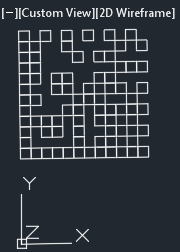
Exporting Barcodes into DXF
The following example is a VB program that stores barcodes in DXF format that can be loaded into SolidWorks, AutoCAD or other CAD or PCB design program.
We also have a javascript-based version of the converter.
How to Proceed
- Download and install the barcode generator;
- Use Visual Basic or any VBA-compatible program like Excel to run the code.
- The example is tested for compatibility with SolidWorks/AutoCAD/ArchiCAD/Revit/NX. If you are working with any other software, try this DXF file first.
A Simple DXF File Structure

Here we will show how to build a simple DXF file which contains a single square barcode module. We use a SOLID DXF entity for this purpose.
To draw a square SOLID entity, you need to specify (x,y,z) coordinates for its corners. If you'll look into this sample DXF file, you will see multiple sequences that look like:
10 X1 20 Y1 30 Z1 11 X2 21 Y2 31 Z2 12 X3 22 Y3 32 Z3 13 X4 23 Y4 33 Z4
Where the codes 10, 20, 30 are the group codes:
- Codes 10, 11, 12, 13 are group codes of X coordinate of the first, second, third and fourth corner.
- Codes 20, 21, 22, 23 are group codes of Y coordinate of the first, second, third and fourth corner.
- Codes 30, 31, 32, 33 are group codes of Z coordinate of the first, second, third and fourth corner. We do not use Z coordinates and always specify 0 after the group codes 30-33.
The listing shown here contains one SOLID entity at the following coordinates (X, Y, Z): (1, 2, 0), (2, 2, 0), (1, 1, 0), (2, 1, 0):
0
SECTION
2
HEADER
9
$ACADVER
1
AC1006
0
ENDSEC
0
SECTION
2
ENTITIES
0
SOLID
8
barcode
10
1
20
2
30
0
11
2
21
2
31
0
12
1
22
1
32
0
13
2
23
1
33
0
0
ENDSEC
0
EOF
If you want to play with this DXF sample, do not add unnecessary spaces or TAB characters or empty lines. AutoCAD is the most picky program - it will show the "Incomplete DXF file" message or will display an empty drawing sometimes without any warnings.
Also, SolidWorks will accept your file without the 9 $ACADVER 1 AC1006 sequence but AutoCAD will not (AC1006 is the drawing version number for AutoCAD R10).
To tell your CAD program that the DXF file is not unitless, place following sequence into the HEADER:
9
$INSUNITS
70
X
Where the X is:
- 1 for Inches;
- 4 for Millimeters;
- 9 for Mils
More information is available here, look for the $INSUNITS.
DXF Barcode Export with StrokeScribe Class
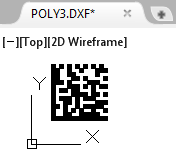
10101010101010
11001001000111
11001100000100
11000110100001
11101000011100
10001110101011
10110110001000
10000111101101
10111010111000
10011010000111
11010010111110
10010101001001
10011001111100
11111111111111
On the left is a sample output of the ZebraBits property provided by StrokeScribe barcode generator.
The ones in the bit string correspond to black modules, zeros - to white modules. We will draw only black modules using SOLID DXF entities.
DXF Converter - the Code Example
To create a DXF file, run the dxf_barcode(). In the write_barcode() call, specify a path to the DXF file, X/Y coordinates of the barcode and width/height of the barcode modules (the code works with millimeters). For 2D barcodes, you must use the same value both for width and height.
Sub write_header(file As Integer)
Print #file, 0
Print #file, "SECTION"
Print #file, 2
Print #file, "HEADER"
Print #file, 9
Print #file, "$ACADVER" ' AutoCAD drawing version number
Print #file, 1
Print #file, "AC1006" ' AC1006 = R10, AC1009 = R11/R12, AC1012 = R13, AC1014 = R14
Print #file, 9
Print #file, "$INSUNITS" ' Default drawing units.
Print #file, 70
Print #file, 4 ' 1 = Inches; 2 = Feet; 3 = Miles; 4 = Millimeters; 5 = Centimeters; 6 = Meters
Print #file, 0
Print #file, "ENDSEC"
Print #file, 0
Print #file, "SECTION"
Print #file, 2
Print #file, "ENTITIES"
End Sub
Sub write_endsec(file As Integer)
Print #file, 0
Print #file, "ENDSEC"
Print #file, 0
Print #file, "EOF"
End Sub
Sub writexyz(file As Integer, x As Integer, y As Integer, corner_number As Integer)
Print #file, 10 + corner_number ' Group codes 10,11,12,13 are X1,X2,X3,X4 coordinates
Print #file, x ' of the SOLID entity.
Print #file, 20 + corner_number ' Y1, Y2, Y3, Y4 coordinates of the SOLID entity.
Print #file, y
Print #file, 30 + corner_number ' Z1, Z2, Z3, Z4 are always =0
Print #file, 0
End Sub
Sub write_solid(file As Integer, x As Integer, y As Integer, w As Integer, h As Integer)
Print #file, "0"
Print #file, "SOLID"
Print #file, "8"
Print #file, "barcode" ' The layer name
writexyz file, x, y, 0 ' Four corners of the SOLID entity. 0,1,2,3 are the corner numbers.
writexyz file, x + w, y, 1
writexyz file, x, y - h, 2
writexyz file, x + w, y - h, 3
End Sub
Sub write_barcode(dxf_file_name As String, zebra As String, _
left As Integer, top As Integer, _
modw As Integer, modh As Integer)
Dim file As Integer
file = FreeFile
Open dxf_file_name For Output As file
write_header file ' Writes the HEADER, $ACADVER, $INSUNITS, ENTITIES into the DXF file
Dim x As Integer
Dim y As Integer
x = left
y = top
i = 1
Do
z = Mid(zebra, i, 1)
Select Case z
Case ""
Exit Do
Case "0"
x = x + modw ' We ignore white modules of the barcode
Case "1"
write_solid file, x, y, modw, modh ' Writes a SOLID entity for a black barcode module
x = x + modw
Case Chr(10)
x = left
y = y - modh
End Select
i = i + 1
Loop
write_endsec file ' Writes ENDSEC and EOF
Close #file
End Sub
' We provide this DXF-to-VBA converter as open source.
' You may modify the code as you want and use it to draw anything else than barcodes.
' But please keep the link to our web site, https://strokescribe.com
Private Sub dxf_barcode()
Dim ss As StrokeScribeClass
Set ss = CreateObject("STROKESCRIBE.StrokeScribeClass.1")
ss.Alphabet = DATAMATRIX
ss.Text = "123ABCD"
Dim zebra As String
zebra = ss.ZebraBits ' Free StrokeScribe Class version => see the notes below
write_barcode "c:\poly.dxf", zebra, 0, 20, 1, 1 ' X, Y, width, height
End Sub
You need to add a reference to the "StrokeScribe Class" into your VBA project to run this code.
A ready-to-use DXF file sample can be downloaded here.
Free version of the barcode generator provides limited functionality for zebra pattern generation. You can test the above code only on small barcodes or use the pre-built zebra patterns of large barcodes shown below.
Exporting Linear Barcodes

To produce linear barcodes (CODE 128, EAN codes, CODE 11), modify the above code in the following way:
ss.Alphabet = CODE128
ss.Text = "A"
Dim zebra As String
zebra = ss.ZebraBits
write_barcode "c:\poly.dxf", zebra, 5, 15, 1, 10 ' The width/height ratio of this barcode is 1:10.
The ready-to-use DXF file is available here.
Exporting 2D Barcodes
Some examples of 2D barcode customization:
Data Matrix
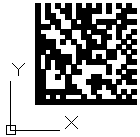
To create a Data Matrix barcode, make the following modifications in the VBA code shown above.
ss.Alphabet = DATAMATRIX
ss.Text = "ABCDEF"
Dim zebra As String
zebra = ss.ZebraBits
write_barcode "c:\poly.dxf", zebra, 0, 0, 1, 1
QR Code
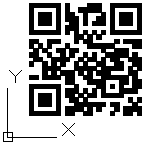
To create a QR Code, make the following modifications in the DXF converter's VBA code.
ss.Alphabet = QRCODE
ss.Text = "ABCDEFGH"
Dim zebra As String
zebra = ss.ZebraBits
write_barcode "c:\poly.dxf", zebra, 0, 0, 1, 1
Here you can download a ready-to-use DXF file.
Qr Codes That Use UTF-8
To create a barcode that contains national characters and needs to be scanned by mobile devices, modify the CodePage property as shown below.
ss.Alphabet = QRCODE
ss.CodePage = 65001 ' 65001 = UTF-8
ss.Text = "ΞΟΠΡΣΤΥΦ"
Dim zebra As String
zebra = ss.ZebraBits
write_barcode "c:\poly.dxf", zebra, 0, 0, 1, 1
PDF417
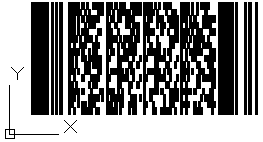
To produce a PDF417 barcode, make the following changes in the DXF converter's code:
ss.Alphabet = PDF417
ss.Text = "ABCDE"
Dim zebra As String
zebra = ss.ZebraBits
write_barcode "c:\poly.dxf", zebra, 0, 0, 1, 3 ' The typical module width/height ratio for PDF417 1:3.
Here you can download a pre-built DXF file.
Testing the Converter with ArchiCAD
Now we can report our DXF barcode converter works with ArchiCad. You can download the pre-built test drawings (PDF417, QR Code, Data Matrix, CODE 128) or make a VB6/VBA-based converter yourself if you have commercial version of StrokeScribe software.
Execute the File->External Content->Place External Drawing command to load a DXF file:
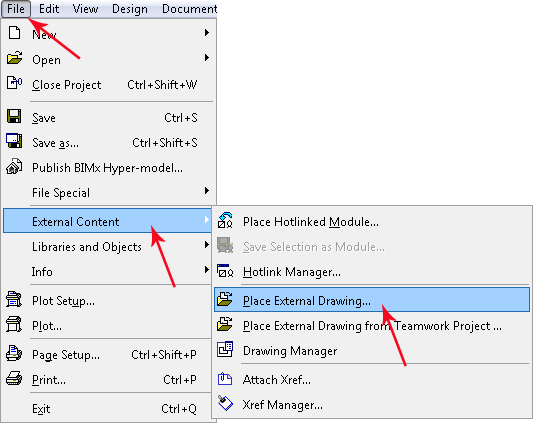
A screenshot of ArchiCAD 19 with some barcodes loaded from DXF drawings:

Testing the Converter with Revit
Our barcode DXF converter has been tested with Revit. Before trying the code, you can download and import the pre-built test barcode drawings (PDF417, QR Code, Data Matrix, CODE 128).
To insert a barcode into an existing drawing, go to the Insert tab, and click Import CAD (the picture below shows the Revit Architecture 2015):

In the Import CAD Formats dialog, select a previously downloaded barcode file. All barcode samples are designed in millimeters so you may need to adjust the Import units to not to loose the small barcode image on a big drawing.
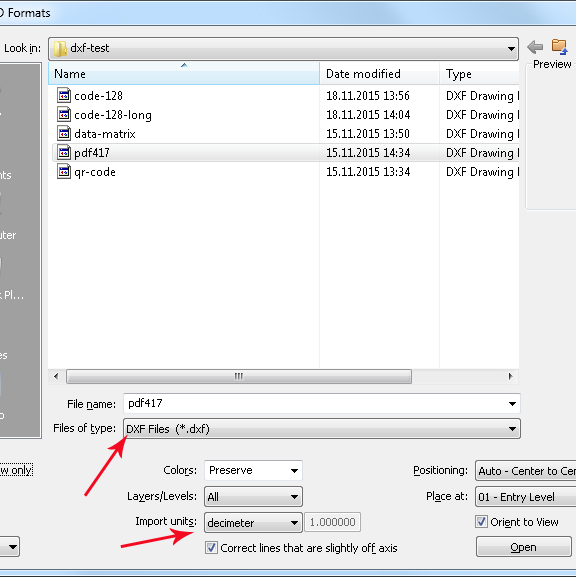
Testing the Converter with Siemens NX
Our barcode DXF converter has been tested with NX. Before trying the code, you can download and import the pre-built test barcode drawings (PDF417, QR Code, Data Matrix, CODE 128).
To import a barcode drawing, go to File>Import>AutoCAD DXF/DWG:
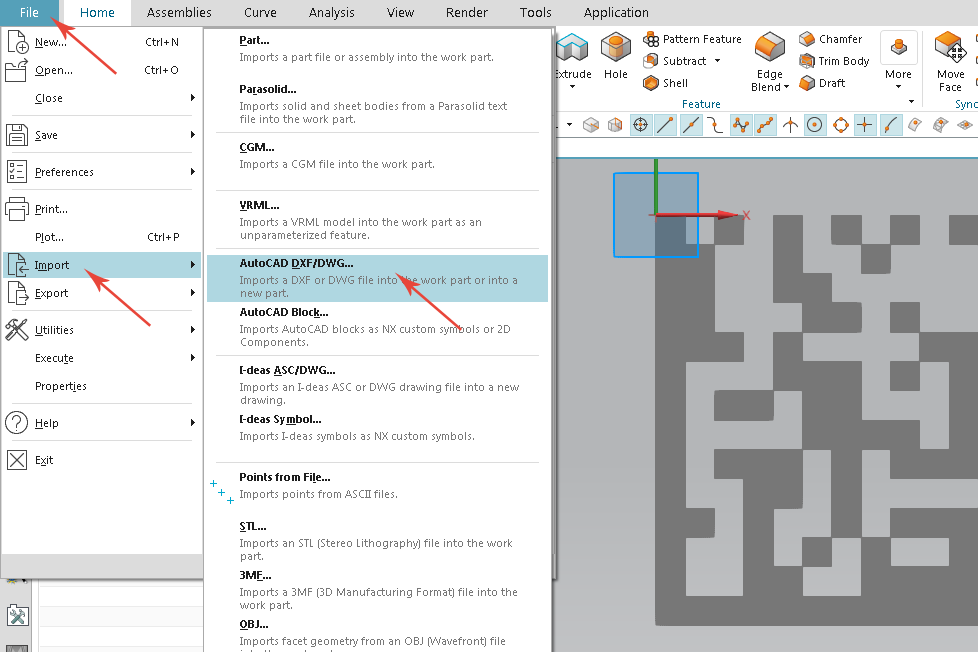
Related Tutorials
- Exporting barcodes into DXF with JS-based converter
- Barcode in AutoCAD
- Barcode in SolidWorks
- Drawing barcode in Autodesk Inventor
- Drawing barcode in Siemens NX
© 2025 StrokeScribe. All rights reserved. Use of any portion of this site constitutes acceptance of our Terms of Use and Privacy Policy. The website material may not be reproduced, except with the prior written permission.